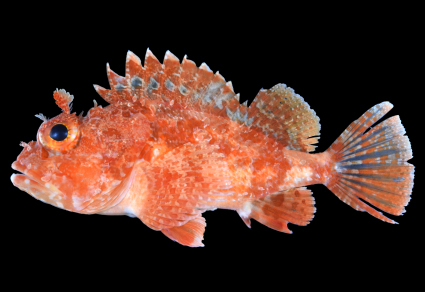Abstract
This study presents a redescription of the Japanese Shortspined Scorpionfish, Scorpaena brevispina, a previously described species based on limited morphological data from the holotype. The redescription incorporates an expanded dataset from 14 collected specimens from the Sagami Sea, Japan, including additional morphological characters, meristic counts, and morphometric analyses, providing a more comprehensive understanding of the species. Morphological comparisons with closely related taxa support the validity of S. brevispina, refining its diagnostic characters: 44–46 scale rows in longitudinal series; 23 pored lateral-line scales; 5–7 (usually 6) scale rows above lateral line, 11–14 (12 or 13) below, 6 or 7 between sixth dorsal-fin spine base and lateral line, and 5–7 (6) between last dorsal-fin spine base and lateral line; 3–5 (4) pre-dorsal scale rows; 17 or 18 (18) gill rakers; anterior surface of preocular spine with three vertical or slightly oblique ridges in large specimens; anterior lacrimal spine with 1 or 2 additional spinous point, directed anteroventrally; lateral lacrimal spine present, with 1 spinous point; body relatively deep [depth 34.9–42.0% of standard length (SL)]; third to fifth dorsal-fin spine lengths 15.9–20.3% of SL, 16.0–20.1% of SL, and 16.1–20.2% of SL, respectively. The study also provides ecological observations, further contributing to knowledge of the species’ natural history and biogeography.
References
- Anthes, N., Theobald, J., Gerlach, T., Meadows, M.G. & Michiels, N.K. (2016) Diversity and ecological correlates of red fluorescence in marine fishes. Frontiers in Ecology and Evolution, 4, 126. https://doi.org/10.3389/fevo.2016.00126
- John, L., Santon, M. & Michiels, N.K. (2023) Scorpionfish rapidly change colour in response to their background. Frontiers in Zoology, 20, 10. https://doi.org/10.1186/s12983-023-00488-x
- Motomura, H. (2004a) New species of scorpionfish, Scorpaena cocosensis (Scorpaeniformes: Scorpaenidae) from the Cocos Islands, Costa Rica, eastern Pacific Ocean. Copeia, 2004 (4), 818–824. https://doi.org/10.1643/CI-04-179R
- Motomura, H. (2004b) Revision of the scorpionfish genus Neosebastes (Scorpaeniformes: Neosebastidae) with descriptions of five new species. Indo-Pacific Fishes, 37, 1–76.
- Motomura, H. & Senou, H. (2008) A new species of the scorpionfish genus Scorpaena (Scorpaenidae) from Izu Peninsula, Pacific coast of Japan. Journal of Fish Biology, 72, 1761–1772. https://doi.org/10.1111/j.1095-8649.2008.01862.x
- Motomura, H., Last, P.R. & Yearsley, G.K. (2005a) Scorpaena bulacephala, a new species of scorpionfish (Scorpaeniformes: Scorpaenidae) from the northern Tasman Sea. Zootaxa, 1043 (1), 17–32. https://doi.org/10.11646/zootaxa.1043.1.2
- Motomura, H., Last, P.R. & Yearsley, G.K. (2006) New species of shallow water scorpionfish (Scorpaenidae: Scorpaena) from the central coast of Western Australia. Copeia, 2006 (3), 360–369. https://doi.org/10.1643/0045-8511(2006)2006[360:nsosws]2.0.co;2
- Motomura, H., Paulin, C.D. & Stewart, A.L. (2005b) First records of Scorpaena onaria (Scorpaeniformes: Scorpaenidae) from the southwestern Pacific Ocean, and comparisons with the Northern Hemisphere population. New Zealand Journal of Marine and Freshwater Research, 39, 865–880. https://doi.org/10.1080/00288330.2005.9517358
- Senou, H., Matsuura, K. & Shinohara, G. (2006) Checklist of fishes in Sagami Sea with zoogeographical comments on shallow water fishes occurring along the coastlines under the Influence of the Kuroshio Current. Memoirs of the National Science Museum, 41, 389–542.
- Sparks, J.S., Schelly, R.C., Smith, W.L., Davis, M.P., Tchernov, D., Pieribone, V.A. & Gruber, D.F. (2014) The covert world of fish biofluorescence: a phylogenetically widespread and phenotypically variable phenomenon. PLoS ONE, 9, e83259. https://doi.org/10.1371/journal.pone.0083259
- Wibowo, K. & Motomura, H. (2021) Review of Indo‑Pacific species of the scorpionfish genus Scorpaena (Teleostei: Scorpaenidae), with descriptions of two new species from the west coast of Australia. Ichthyological Research, 69, 199–235. https://doi.org/10.1007/s10228-021-00827-0
- Zawada, D.G. & Mazel, C.H. (2014) Fluorescence-based classification of caribbean coral reef organisms and substrates. PLoS ONE, 9, e84570. https://doi.org/10.1371/journal.pone.0084570


